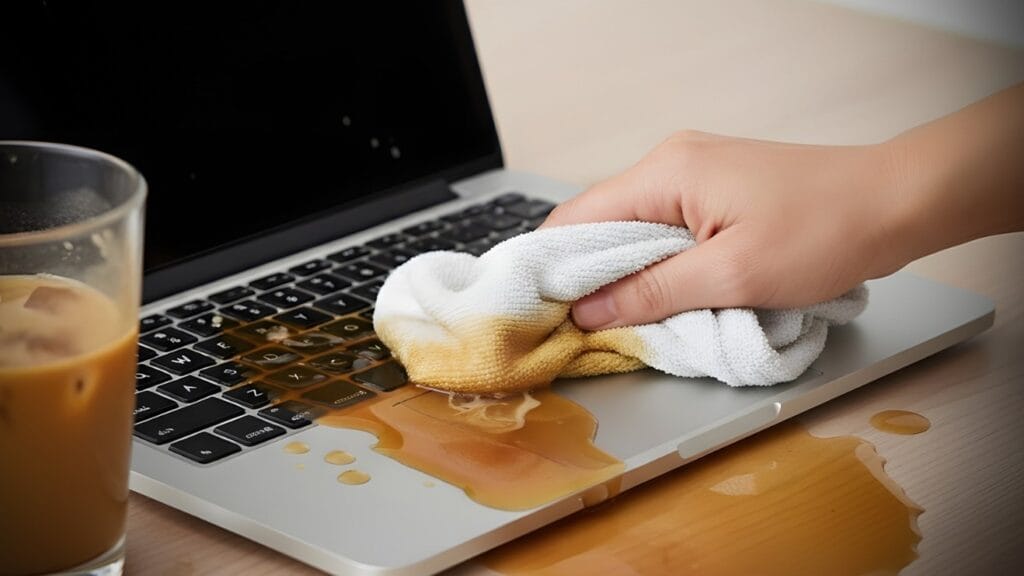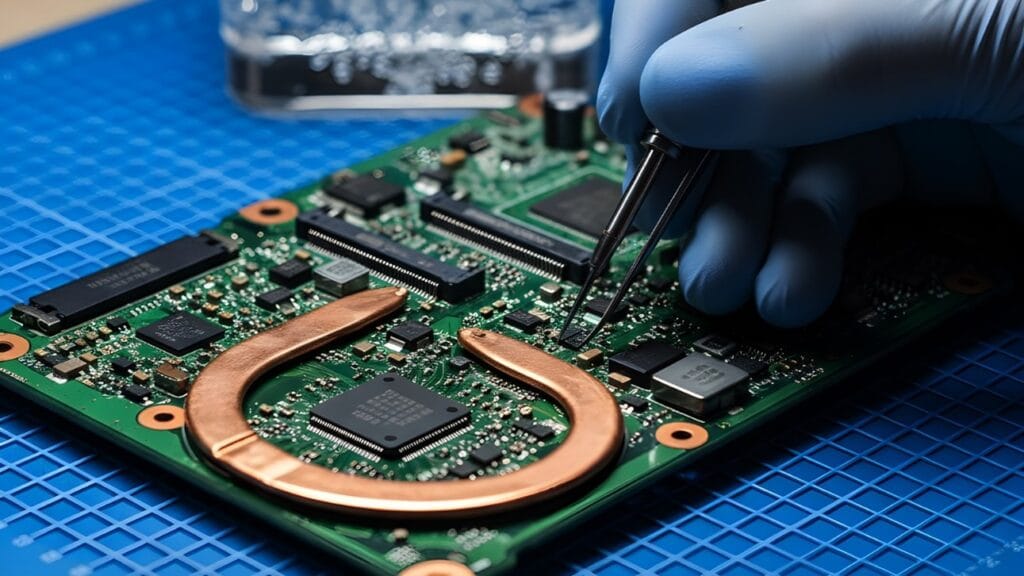
Accidentally spilling water, tea, coffee, or any other liquid on your laptop is one of the most common and stressful tech emergencies. Whether it happens at work, in a café, or at home, liquid exposure can cause short circuits, data loss, and even permanent damage to the motherboard. The key to minimizing the impact is acting quickly. A fast and careful response can greatly improve the chances of saving your laptop and protecting your valuable data.
This step-by-step guide explains exactly what to do when your laptop gets wet — and why acting fast is critical.
Step 1: Power It Down Immediately
When water reaches the internal components of your laptop, electricity becomes the biggest threat. If the device is still running, press and hold the power button to shut it down immediately. Avoid the urge to turn it back on or check if it’s still working, as doing so can cause a short circuit and lead to severe or irreversible damage.
Powering a wet laptop can cause an instant short circuit, especially in sensitive areas like the motherboard. Even brief contact between water and live circuits is enough to damage essential components such as the CPU, GPU, or RAM. These are not only expensive parts to replace but also critical to the overall performance of your device.
Turning off the laptop immediately helps prevent internal arcing and further electrical damage. Acting fast at this stage can make the difference between a quick recovery and a costly repair or even a complete device replacement.
Step 2: Unplug and Disconnect All Devices
Once the laptop is powered off, it’s important to cut off all external power sources immediately. Unplug the charger to stop any flow of electricity into the device, and remove all connected accessories such as USB drives, HDMI cables, external hard drives, and SD cards. If the laptop has a removable battery, carefully take it out to fully isolate the system from any remaining power.
This step is critical because even after shutting down, residual current can still flow through connected devices or power inputs. That continuous flow can worsen the damage, increasing the risk of short circuits or component failure. By disconnecting everything, you’re ensuring that no electrical current is circulating through the system, giving your laptop a better chance of recovery.
Step 3: Gently Dry and Drain the Laptop
Next, gently wipe away any visible moisture using a clean, lint-free towel or microfiber cloth. Be sure to dab the surface instead of rubbing it to avoid pushing liquid further inside the device. Once the exterior is as dry as possible, place the laptop upside down in an inverted “V” or tent shape. This position allows gravity to naturally draw any remaining liquid away from the keyboard and internal components.
For best results, open the lid fully to improve airflow. Avoid using heat sources such as hairdryers, heat guns, or direct sunlight, as excessive heat can warp internal parts or cause additional damage. If available, use a fan on a low, cool setting to gently circulate air around the laptop. Allow it to air-dry for at least 24 to 48 hours before attempting to power it on again.
This step is crucial because even a small amount of trapped moisture can lead to corrosion, rust, or electrical short circuits over time. Slow, controlled drying is far safer than applying direct heat and significantly improves the chances of a successful recovery.
Step 4: Stay Calm and Avoid Turning It On
Many people make the mistake of powering their laptop back on after only a few hours, assuming it’s dry because the exterior looks fine. In reality, moisture often remains trapped inside, especially around the motherboard, keyboard circuits, and trackpad. It’s essential to wait at least 24 to 48 hours before restarting the device. If the spill involved sugary liquids like coffee or juice, residue can attract dust and damage internal components over time. Even if the laptop seems to work at first, hidden corrosion can develop and cause serious issues later.
Step 5: Seek Professional Water Damage Repair
Even if your laptop powers on after drying, hidden moisture or corrosion can still damage critical components over time. At Focus PC, we provide expert laptop water damage repair in London using ultrasonic cleaning and board-level diagnostics to restore your device safely.
Our process includes a thorough internal inspection, removal of moisture and residue, precise circuit testing, and careful reassembly. Acting quickly helps prevent further damage, extend your laptop’s life, and protect your valuable data.
Step 6: Backup and Prevent Future Damage
Once your device is working again, it’s wise to take a few simple steps to protect it from future accidents. Use a water-resistant keyboard cover and keep drinks away from your workspace to reduce the risk of spills. A waterproof laptop sleeve is a smart investment for travel, and setting up automatic cloud backups ensures your data stays safe even if your device doesn’t. These small preventive habits can save you from another stressful and costly situation.
Why Acting Quickly Matters After a Spill
When it comes to liquid damage, every minute counts. Corrosion begins almost immediately, and the longer moisture sits inside, the harder and more expensive the repair becomes. A laptop that might be saved with a simple ultrasonic cleaning on Day 1 could require motherboard replacement by Day 3.
Need Fast & Reliable Laptop Water Damage Repair in London? At Focus PC, we provide fast and reliable solutions to protect your device after a spill. Our team offers same-day diagnostics and repair, ultrasonic cleaning, and internal component restoration to address moisture and corrosion effectively. We also provide expert board-level repair services and maintain transparent pricing with no hidden costs. Acting quickly gives your laptop the best chance of recovery, so don’t wait—bring it in as soon as possible for professional care.


